Kathmandu travel - Nepal, Asia
Kathmandu, the capital of Nepal, is nestled in the picturesque Kathmandu Valley, surrounded by the towering Himalayas at an elevation of about 1,400 meters (4,600 feet). As Nepal’s largest city, Kathmandu is a cultural treasure, famous for its UNESCO World Heritage Sites, including Kathmandu Durbar Square, Swayambhunath (Monkey Temple), and the Boudhanath Stupa, all showcasing breathtaking architecture and historical significance. A rich blend of Hinduism and Buddhism, Kathmandu’s cultural diversity is evident in its vibrant festivals, temples, and daily life. Often regarded as the gateway to the Himalayas, Kathmandu attracts adventurers and trekkers seeking access to renowned routes like Everest Base Camp. Beyond its historical and cultural appeal, Kathmandu’s bustling markets and traditional Nepali cuisine offer visitors an immersive and flavorful experience. The surrounding hills also provide stunning views and numerous opportunities for hiking and outdoor activities.
Population Estimate 1.6 million (as of 2024)
Economy: Kathmandu plays a vital role in Nepal’s economy, with tourism being a major driver, especially as the city serves as a gateway for trekking and mountaineering in the Himalayas. As Nepal’s industrial and commercial hub, Kathmandu houses key institutions like the Nepal Stock Exchange, major banks, and international organizations. Visitors can explore bustling economic areas such as New Road and Durbar Marg, where shopping and business opportunities abound. The city is also known for its local products, including handicrafts, pashmina, and carpets, offering unique souvenirs for travelers. While Kathmandu is modernizing with ongoing infrastructure development, it continues to balance its traditional charm with a growing urban landscape.
Landmarks: Boudhanath Stupa, Pashupatinath Temple, Swayambhunath Stupa (Monkey Temple), Kathmandu Durbar Square (Hanuman Dhoka), Garden of Dreams, Bhaktapur Durbar Square, Patan Durbar Square, Changu Narayan Temple
Nepal
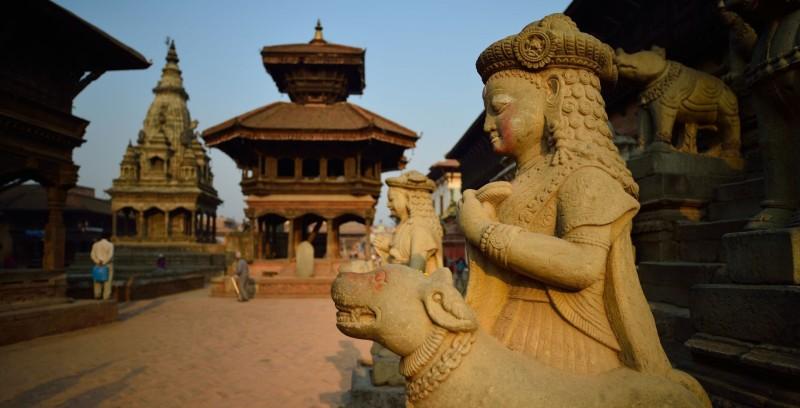
Overview of Kathmandu
History & Cultural Influence
Kathmandu’s history stretches back to ancient times, with archaeological findings pointing to human settlements as early as 167 BC. Legend says the city was created when the Bodhisattva Manjushree drained an ancient lake, giving rise to the fertile Kathmandu Valley. Throughout history, Kathmandu thrived under several dynasties, notably the Licchavi period (400-750 AD), which introduced Buddhism and established the city as a key trade hub between India and Tibet. The Malla Dynasty (13th-18th centuries) further shaped Kathmandu’s cultural identity by developing its iconic pagoda-style temples, intricate palaces, and city squares.
When Prithvi Narayan Shah unified Nepal in 1768, he made Kathmandu the capital, enhancing the city’s architecture and significance. The Rana period (1846-1951) introduced Western influences, leading to the construction of grand buildings like the Garden of Dreams and Singha Durbar, and the establishment of the first schools and hospitals. Culturally, Kathmandu is a melting pot of Hindu and Buddhist traditions, seen in its many UNESCO World Heritage Sites, including Durbar Square, Swayambhunath (Monkey Temple), and Pashupatinath Temple. Known for its artistic craftsmanship—especially intricate wood carvings and metalwork—Kathmandu is also a city of festivals, celebrating events like Dashain and Indra Jatra. Today, it stands as a vibrant metropolis that gracefully blends its ancient heritage with modern development, while striving to preserve its unique cultural identity amidst rapid urbanization.
Interaction with The Locals
You can expect a warm and welcoming reception from the locals. The city is ethnically diverse, with the Newar community making up about 30%, followed by Matwali, Khas Brahmins, and Chhetris. This multicultural blend contributes to a rich tapestry of traditions, languages, and religious practices. While Nepali is the most widely spoken language, English is commonly understood, especially in tourist areas, making communication relatively easy. Locals are known for their hospitality and curiosity, often showing a genuine interest in learning about visitors' cultures. Visitors should respect local customs, especially at religious sites, and may find friendly bargaining a part of shopping at local markets. With a youthful population and a tourism-oriented economy, Kathmandu residents are generally eager to assist and engage with travelers.
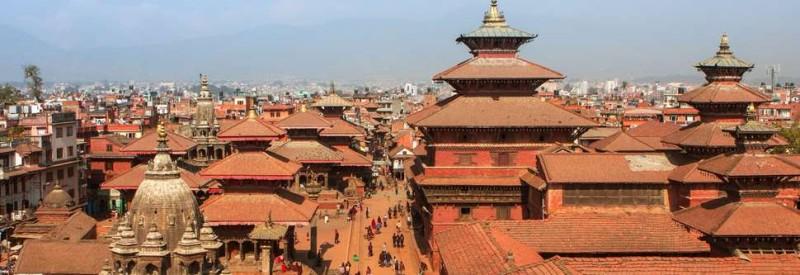
Kathmandu UNESCO heritage sites - © gather
Top attractions in Kathmandu
Swayambhunath Stupa (Monkey Temple)
Location: Atop a hill in western Kathmandu
Swayambhunath, also known as the Monkey Temple, is one of Kathmandu's most iconic and ancient Buddhist sites. The stupa, with its striking white dome and the all-seeing eyes of Buddha painted on its golden spire, is a symbol of enlightenment. The complex is adorned with colorful prayer flags fluttering in the wind, adding to its spiritual atmosphere. As you climb the steps to the top, you’ll be greeted by playful monkeys and breathtaking panoramic views of Kathmandu Valley. The serene environment combined with the hustle of the monkeys makes it a unique destination for both spiritual reflection and sightseeing.
Boudhanath Stupa
Location: Boudha, northeastern Kathmandu
Boudhanath Stupa, one of the largest stupas in the world, is a monumental structure and a key pilgrimage site for Tibetan Buddhists. A UNESCO World Heritage site, its massive white dome is crowned with a golden tower, painted with Buddha’s watchful eyes. Surrounded by monasteries, prayer wheels, and shops, the stupa creates a meditative ambiance where locals and visitors alike walk around in a clockwise direction, spinning prayer wheels as they go. It's a beautiful place to soak in Tibetan culture and spirituality, while also browsing the nearby shops selling traditional handicrafts and religious artifacts.
Pashupatinath Temple
Location: On the banks of the Bagmati River, eastern Kathmandu
Pashupatinath Temple is one of the most sacred Hindu temples dedicated to Lord Shiva. Known for its intricate pagoda-style architecture and detailed wood carvings, this UNESCO World Heritage site is not just a place of worship but also a significant cultural hub. The temple complex is a site for Hindu cremation rituals, with cremation ghats along the riverbanks where these sacred rites are performed. While non-Hindus are not allowed inside the main temple, visitors can explore the surrounding shrines and witness the spiritual rituals from designated areas.
Kathmandu Durbar Square
Location: Central Kathmandu
Kathmandu Durbar Square is a historical masterpiece, featuring a collection of royal palaces, temples, and courtyards that date back to the 12th to 18th centuries. A UNESCO World Heritage site, the square is known for its beautiful Newari architecture, including the iconic Hanuman Dhoka Palace and the Kumari Ghar, home to the living goddess. Walking through the square, you’ll feel transported back in time, surrounded by intricately carved wooden temples and bustling with local life. It’s an essential stop for anyone interested in the rich history and cultural heritage of Kathmandu.
Garden of Dreams
Location: Thamel, central Kathmandu
The Garden of Dreams is an oasis of tranquility amidst the bustling streets of Kathmandu. This neo-classical garden, originally built in the 1920s, features beautifully manicured lawns, serene fountains, and charming pavilions. It's the perfect spot to relax after a day of sightseeing, offering a peaceful escape where you can enjoy a quiet stroll, a good book, or even a light meal at the garden’s cafe. The carefully designed landscape and calm atmosphere provide a welcome retreat from the city’s vibrant energy.
Thamel
Location: Central Kathmandu
Thamel is the beating heart of Kathmandu’s tourism scene. This lively district is packed with shops, restaurants, cafes, and guesthouses, making it the go-to place for travelers. You’ll find everything from trekking gear and local handicrafts to bustling nightlife and street food stalls. Thamel’s narrow streets are alive with the sounds of bargaining and the aroma of Nepali and international cuisine, offering visitors an authentic slice of Kathmandu’s energetic atmosphere. It's a perfect spot for souvenir shopping and soaking in the local vibe.
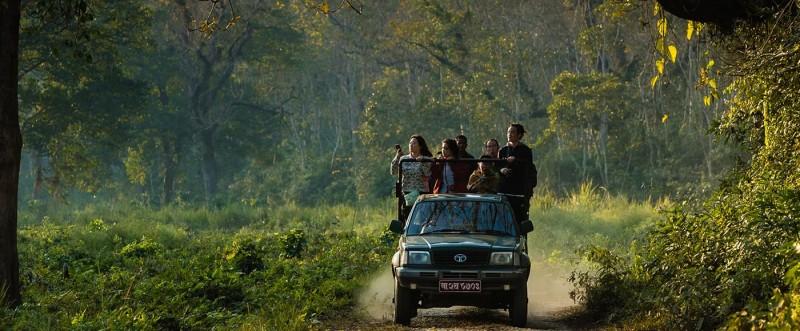
Chitwan Jungle Safari - © gather
Must-Try Dishes in Kathmandu
Kathmandu's culinary scene is a vibrant reflection of its rich cultural heritage, influenced by various ethnic groups and traditions. Here are must-try dishes that showcase the unique flavors of the city:
Dal Bhat
Dal Bhat is more than just a meal in Nepal—it's a way of life. This simple yet hearty dish consists of lentil soup (dal) paired with steamed rice (bhat), often accompanied by a variety of side dishes like vegetable curries, pickles (achar), and sometimes yogurt. It’s a staple in almost every Nepali household, eaten daily, and provides a perfect balance of nutrients, making it both satisfying and wholesome. When you’re in Kathmandu, expect to be served Dal Bhat as a gesture of hospitality, offering you a taste of the heart of Nepali cuisine.
Momo
Momos are Kathmandu’s favorite snack, and you’ll find these Tibetan-style dumplings on almost every street corner. Typically filled with minced meat—chicken, buffalo, or pork—or vegetables, momos are wrapped in dough and either steamed or fried. They’re served with a spicy, tangy dipping sauce called achar, which adds a delicious kick. Whether you enjoy them as street food or in a local restaurant, momos are a must-try for any visitor, representing a beautiful fusion of Tibetan and Nepali flavors.
Samay Baji
Samay Baji is a traditional Newari dish that offers a true feast for the senses. Served on a large platter, this dish includes a mix of beaten rice (chiura), barbecued buffalo meat (choila), boiled eggs, pickled vegetables, and more. Often eaten during festivals or special occasions, Samay Baji showcases the rich culinary heritage of the Newar community. The combination of flavors and textures makes it an unforgettable experience, providing a deep dive into the authentic cuisine of the Kathmandu Valley.
Chatamari
Often called the "Nepali pizza," Chatamari is a delicious rice flour crepe topped with a variety of ingredients such as minced meat, vegetables, and eggs. It’s a traditional dish of the Newar community, typically served during festivals and family gatherings. While it may resemble a pizza, Chatamari has its own unique flavors and texture, making it a delightful snack or meal. This dish highlights the region’s agricultural roots and is a perfect representation of Nepal’s creative and flavorful approach to food.
Gundruk
Gundruk is a unique and tangy dish made from fermented leafy greens, like mustard or radish leaves. This traditional Nepali food is valued for its distinctive sour flavor and nutritional benefits. Often served as a side dish or added to soups, Gundruk is particularly popular in the winter months as a preserved vegetable. The fermentation process reflects Nepal's practical approach to food preservation, and it’s a taste of local tradition you won’t want to miss while exploring the culinary scene in Kathmandu.
Sel Roti
Sel Roti is a beloved Nepali treat, especially during festivals like Dashain and Tihar. Made from rice flour, this doughnut-shaped snack is deep-fried to perfection, offering a crispy exterior with a soft and chewy inside. Sel Roti is enjoyed as both a snack and dessert, often paired with tea. Its festive nature makes it a symbol of celebration in Nepali culture, and sampling this sweet, golden treat is a delicious way to experience Nepal’s culinary traditions.
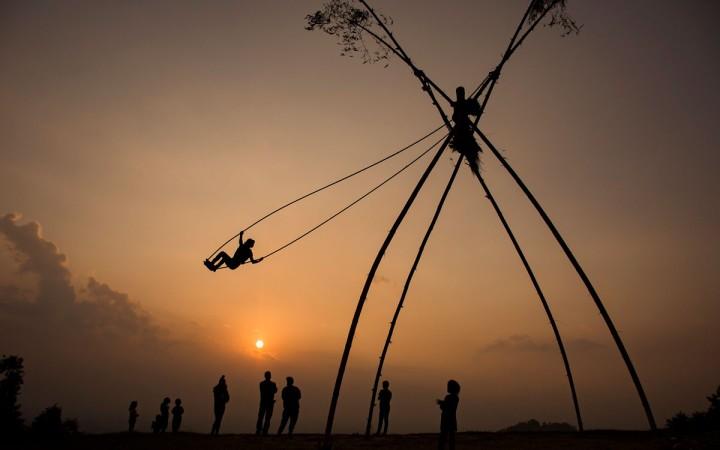
Dashain - © Ace the Himalaya
Festivals & Local Celebrations
Dashain
Time: September/October (varies annually based on the lunar calendar)
Dashain is Nepal’s most significant and longest festival, lasting for 15 days. During this time, Kathmandu comes alive with religious ceremonies, family gatherings, and cultural traditions. Visitors can witness vibrant celebrations at temples across the city, with locals offering prayers and sacrifices to the goddess Durga. One of the most iconic sights is the tika ceremony, where elders place a red powder mark on the foreheads of younger family members as a blessing. Kite-flying is a popular Dashain activity, and you’ll see colorful kites filling the sky. Keep in mind, many businesses and government offices close during this period as families gather for feasts and celebrations.
Tihar (Diwali)
Time: October/November (usually two weeks after Dashain)
Also known as the Festival of Lights, Tihar is a beautiful five-day celebration that lights up Kathmandu with a magical glow. Homes and streets are decorated with oil lamps, candles, and colorful rangoli designs at the entrances. One unique aspect of Tihar is Kukur Tihar, the day dedicated to honoring dogs, where they are adorned with garlands and treated to special meals. Visitors can enjoy the festive atmosphere with fireworks, music, and groups performing Deusi and Bhailo, traditional songs and dances that are performed door-to-door. It’s a time of joy and light, symbolizing the bond between humans and the divine.
Indra Jatra
Time: September (dates vary annually)
Indra Jatra is an eight-day festival celebrating Indra, the god of rain, and marking the end of the monsoon season. Kathmandu's Durbar Square is the heart of the festivities, where visitors can witness the grand chariot procession of Kumari, the living goddess, through the old town. The raising of the Yosin, a ceremonial wooden pole, is another highlight, symbolizing the festival’s spiritual significance. Masked dance performances, representing deities and demons, add to the vibrant cultural atmosphere. The public appearance of the Kumari, who blesses onlookers, is a rare and special moment during Indra Jatra.
Holi
Time: February/March (on the full moon day of Falgun in the Hindu calendar)
Holi, the Festival of Colors, is one of the most joyous and energetic celebrations in Kathmandu, marking the arrival of spring. During Holi, the streets become a riot of color as locals and visitors alike throw colorful powders and water at each other. Areas like Thamel turn into a carnival, with music, dancing, and laughter filling the air. Bonfires are lit the night before to signify the victory of good over evil, and special sweets and treats can be found in the local markets. Holi is a joyful experience that brings the community together in celebration and playfulness.
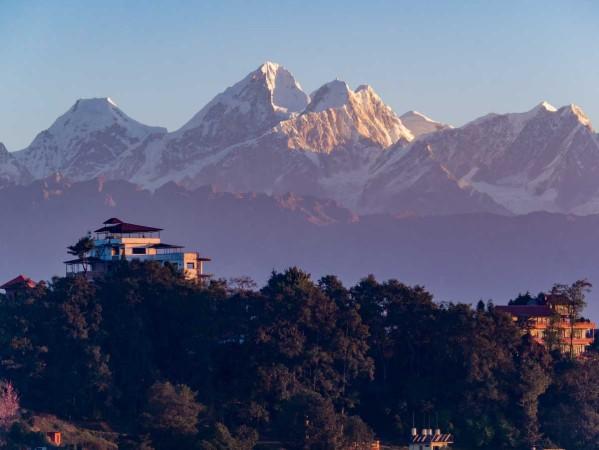
Nagarkot Sunrise - © gather
What to Do in Kathmandu
Outdoor Adventures in Kathmandu
For thrill-seekers and nature lovers, Kathmandu offers some truly unforgettable outdoor experiences.
- Everest Scenic Flight: Experience the breathtaking beauty of the Himalayas with a thrilling 1-hour scenic flight from Kathmandu, where you’ll get up close views of Mount Everest and the surrounding peaks.
- Nagarkot Sunrise Hike: Take a day hike to Nagarkot to witness a stunning sunrise over the Himalayas. Along the way, stop by the ancient Changu Narayan temple, a UNESCO World Heritage site, and soak in the local culture and history.
- Chitwan Jungle Safari: Venture into the wild with a 2 to 4-day jungle safari at Chitwan National Park, home to exotic wildlife like one-horned rhinoceroses, Bengal tigers, and over 500 bird species. It's the perfect getaway for those seeking adventure and a connection with nature.
Cultural Experiences in Kathmandu
Kathmandu is a cultural treasure trove, with rich history and traditions waiting to be explored.
- UNESCO World Heritage Tour: Discover the seven UNESCO World Heritage sites in Kathmandu, including the iconic Boudhanath Stupa, Swayambhunath (Monkey Temple), the sacred Pashupatinath Temple, and the historic Kathmandu Durbar Square.
- Bhaktapur Exploration: Step back in time with a visit to the medieval city of Bhaktapur, famous for its intricate architecture, vibrant pottery workshops, and deep-rooted Newari culture.
- Narayanhiti Palace Museum: Tour the former royal palace, now transformed into a museum that offers an intriguing look into Nepal’s history and the lives of the Shah dynasty.
- Boudhanath Stupa: Visit Nepal's largest stupa, a sacred Buddhist site surrounded by monasteries and Tibetan handicraft shops, perfect for soaking in the spiritual atmosphere.
- Pashupatinath Temple: Observe the solemn Hindu cremation rituals along the banks of the Bagmati River at this revered temple complex, a sacred site for Hindus from around the world.
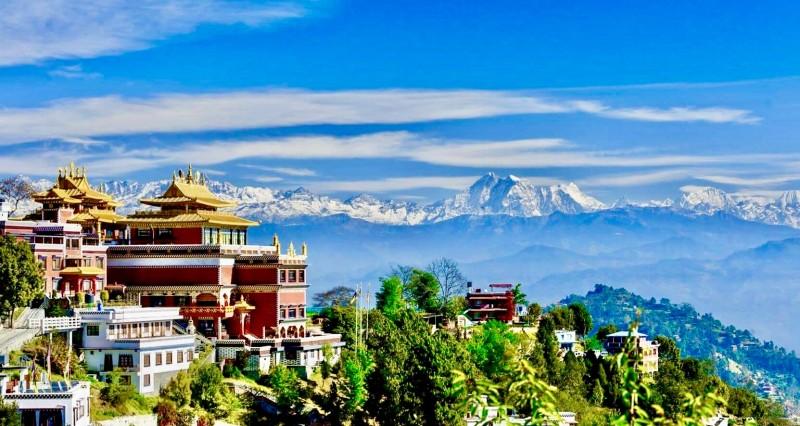
Nagarkot Sunrise Hike - © gather
Weather in Kathmandu: Best Time to Visit
Average Temperatures
Kathmandu experiences a range of temperatures throughout the year. The hottest month is June, with average temperatures around 24.4°C (75.9°F), while January is the coldest, averaging 11°C (51.8°F). During summer (April-October), highs typically reach 27-29°C (81-84°F), offering warm but manageable weather. In winter (December-February), daytime highs hover around 19-20°C (66-68°F), but nights can get quite chilly, dipping to 3-5°C (37-41°F).
Rainfall
Kathmandu’s wettest months are July and August, with rainfall reaching up to 384 mm (15.1 inches) and 343 mm (13.5 inches) respectively, during the monsoon season (June to September). If you're looking for drier weather, November to February are the driest months, with rainfall typically below 25 mm (1 inch) per month.
Best Time to Travel
For the best experience in Kathmandu, spring (March to May) and autumn (mid-October to mid-November) are ideal. These seasons offer pleasant temperatures and clearer skies, making it perfect for outdoor activities, sightseeing, and trekking.
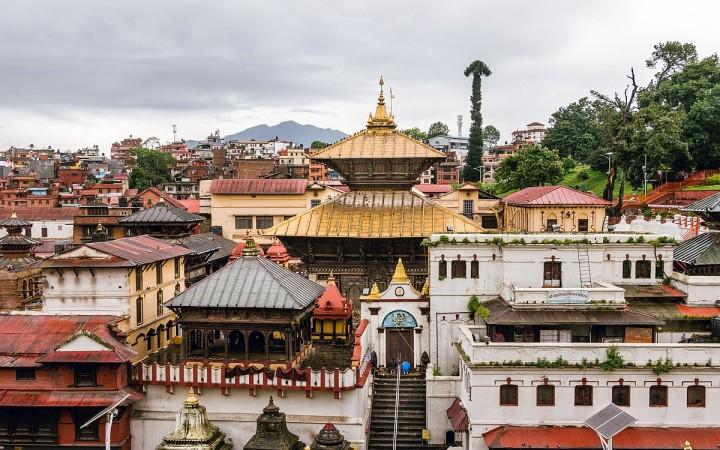
Pashupatinath Temple - © Bijay Chaurasia
Culture Etiquette in Kathmandu
Greetings and Interactions
When greeting locals in Kathmandu, use the traditional "Namaste" gesture, pressing your palms together with a slight bow. Public displays of affection between opposite sexes are generally discouraged, as Nepalese culture leans toward modesty. When giving, receiving, or eating, always use your right hand, as the left hand is considered unclean. It's also important to ask permission before taking photos, especially in religious areas, to show respect for the culture.
Dress Code
Modesty is highly valued in Nepal, especially when visiting temples or religious sites. Ensure your shoulders and knees are covered, particularly for women. It's customary to remove your shoes before entering homes, temples, or any sacred space as a sign of respect.
Religious Respect
In Kathmandu, religious customs are taken seriously. Always walk clockwise around Buddhist stupas and prayer wheels, and avoid touching religious objects or offerings in temples. Some Hindu temples may restrict entry to non-Hindus, so it's a good idea to check before entering.
Dining Etiquette
Before and after meals, it’s customary to wash your hands. If you're dining in a traditional setting, eat with your right hand, and it’s polite to accept food or drink when offered, even if you don’t consume it all.
General Etiquette
Be mindful to remove your shoes when entering homes or religious sites. Instead of pointing with your finger, use your chin or an open hand. Additionally, avoid touching someone’s head, as it’s considered sacred, and never point the soles of your feet at people or religious objects.
Social Hierarchy
Show extra respect to elders and those in positions of authority. Using appropriate titles when addressing people demonstrates politeness and cultural awareness.
Gift Giving
When giving or receiving gifts, use both hands as a sign of respect. Avoid giving leather items, as cows are considered sacred in Hindu culture.
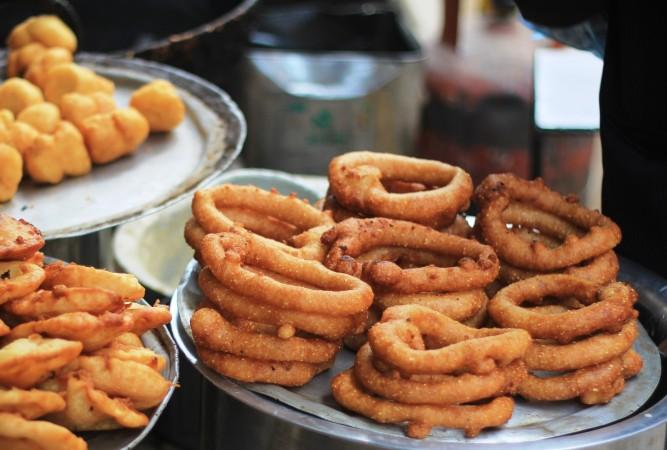
Sel Roti - © gather
Shopping in Kathmandu
Thamel District
Thamel is Kathmandu's go-to shopping destination, famous for its bustling, narrow streets packed with shops selling everything from trekking gear to handmade crafts. This pedestrian-friendly area is a delight to explore, but be cautious of overly cheap pashminas, as some may not be authentic.
What to Buy: Pashminas, singing bowls, jewelry, Tibetan prayer flags.
Jawalakhel
Located in southern Patan, Jawalakhel is known for its exquisite Tibetan-style wool carpets and intricate Buddhist statuary. Don’t miss the Tibetan refugee workshops, where you can see artisans at work and buy authentic, high-quality crafts directly from the source.
What to Buy: Hand-knotted carpets, metal crafts.
Fair Trade Shops (Durbar Marg, Lazimpat, Patan)
Kathmandu is home to several fair-trade shops supporting local artisans and communities. Notable ones include Mahaguthi in Kupondole and One Tree Stop on Durbar Marg, which also features a café run by deaf staff. These shops offer ethically sourced, beautifully crafted items.
What to Buy: Handicrafts, textiles, unique design products.
Kathesimbu Stupa and Boudhanath Stupa
For traditional Tibetan items, these areas are a must-visit. The shops surrounding the stupas offer a serene yet vibrant shopping experience, with a rich cultural atmosphere perfect for sightseeing and souvenir hunting.
What to Buy: Tibetan prayer flags, brocade, embroidered silks, traditional Nepali hats (topis).
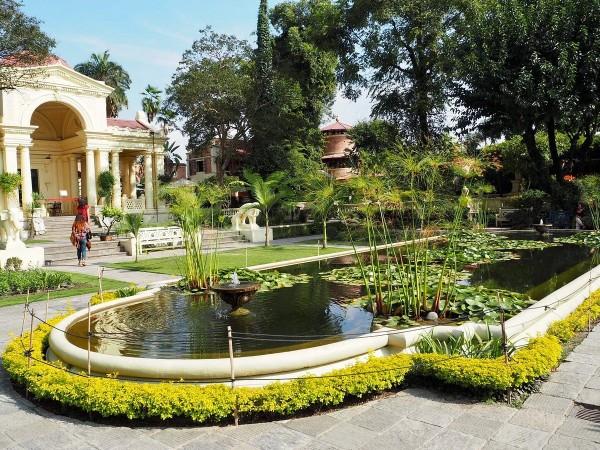
Garden of Dreams - © gather
Essential Travel Information
Getting Around Kathmandu
- Buses: The most common form of public transport, buses in Kathmandu are easy to spot with their bright colors. They connect most parts of the city and are a cost-effective way to travel, though they can get crowded during peak hours. Fares range from NPR 25 to NPR 50.
- Sajha Buses: Government-run Sajha Buses offer a more comfortable experience with fixed routes and designated stops. They are a reliable option for navigating the city.
- Rickshaws: For shorter distances, rickshaws are a fun and practical choice, especially for navigating the narrow streets. Be sure to negotiate the fare before starting, as rickshaws typically don’t have meters.
- Metered Taxis: Most taxis are equipped with meters, but drivers may not always use them. It’s a good idea to negotiate the fare before your trip, particularly in tourist-heavy areas like Thamel. Fares for short trips within the city usually range from NPR 300 to NPR 600.
- Motorbike Taxis: For a faster and more adventurous option, motorbike taxis are available. They tend to be cheaper than traditional taxis and can zip through traffic easily.
- Walking: Kathmandu’s most popular areas, like Thamel and Durbar Square, are best explored on foot. Walking allows you to fully experience the local culture, and you may discover hidden gems along the way.
- Bicycle Rentals: If you’re feeling adventurous, you can rent a bicycle from one of the many rental shops in Thamel. Mountain bikes are a popular choice for exploring not only the city but also the scenic surroundings.
ATM and Banking Services in Kathmandu
Kathmandu has a well-established banking system, with numerous ATMs and bank branches conveniently located across the city. Major banks like Nepal Investment Bank Ltd. (NIBL), Standard Chartered Bank Nepal Limited, Himalayan Bank Limited, Nabil Bank Limited, and Nepal SBI Bank Limited all offer ATM services, especially in popular tourist areas like Thamel. Most ATMs in Kathmandu accept international cards connected to Visa, Mastercard, Maestro, and Cirrus networks.
Daily withdrawal limits typically range from NPR 10,000 to NPR 35,000 (roughly USD 100-350), and ATM fees for international cards generally fall between NPR 200-400 per transaction. To avoid any issues, it’s always a good idea to notify your bank of your travel plans in advance.
Accommodation Choices in Kathmandu
Kathmandu offers a diverse range of accommodation options that cater to all kinds of travelers:
- Luxury Hotels: These are often located near key tourist attractions and offer modern amenities, ensuring a comfortable stay.
- Mid-range Hotels and Guesthouses: These are scattered throughout the city, especially in areas like Thamel, providing a balance of comfort and affordability.
- Budget Accommodations: Hostels and budget hotels are perfect for backpackers and those traveling on a tight budget, offering basic amenities at low prices.
- Heritage Properties: For a unique cultural experience, some hotels are housed in beautifully restored heritage buildings, allowing you to enjoy a mix of tradition and modern comfort.
Articles for you

Explore Yala National Park - Sri Lanka Travel, Asia
Tucked away in Sri Lanka’s southeastern corner, Yala National Park is where wild nature meets deep tradition. Known worldwide for its leopard population, the park is also home to elephants, sloth bears, crocodiles, and hundreds of bird species. Beyond wildlife, Yala opens doors to a cultural landscape dotted with ancient temples, Buddhist ruins, and coastal villages. For travelers seeking more than just a safari, Yala offers a chance to explore eco-tourism, local communities, and sacred heritage sites.
Population: The Yala National Park area doesn’t have a human population.
Economy: The economy around Yala National Park thrives on a blend of eco-tourism, agriculture, and local services. Safari tours, eco-lodges, and cultural experiences drive steady income for nearby towns like Tissamaharama and Kataragama, supporting thousands of families.
Landmarks: Famous for Block I of Yala and wildlife encounters, including elephants, sloth bears, crocodiles, and exotic bird species.

Explore Galle - Sri Lanka Travel, Asia
Nestled on Sri Lanka’s southern coastline, Galle is a vibrant city where history meets the sea. Its cobbled streets, colonial architecture, and serene beaches make it a must-visit destination for travelers seeking a blend of culture, adventure, and relaxation. A UNESCO World Heritage site, Galle captivates visitors with its Dutch Fort, bustling markets, and friendly locals. Whether you’re exploring the ramparts at sunset or savoring fresh seafood by the shore, Galle promises an unforgettable journey into Sri Lanka’s heritage.
Population: Approximately 113,000 in 2023.
Economy: Galle’s economy thrives on tourism, trade, and fisheries. The city’s historic fort, colonial architecture, and coastal charm draw thousands of international visitors each year, making tourism its main economic driver. Fishing remains vital for local livelihoods, supplying fresh seafood across the region.
Landmarks: Famous for the Galle Fort, Dutch Reformed Church & Maritime Museum, and Unawatuna Beach.

Explore Bentota - Sri Lanka Travel, Asia
Nestled along Sri Lanka’s southwestern coast, Bentota is a tropical paradise that blends golden beaches, vibrant culture, and thrilling adventures. Famous for its calm waters, luxury resorts, and scenic river estuary, Bentota has become a top destination for travelers seeking both relaxation and authentic experiences. From serene beach walks at sunrise to adrenaline-pumping water sports, this coastal town offers a perfect balance of leisure and exploration. With its proximity to Colombo and Galle, Bentota is easy to reach, making it an ideal stop for both short escapes and extended holidays.
Population: Approximately 37,000 in 2023.
Economy: Bentota’s economy thrives mainly on tourism, which drives local businesses such as hotels, restaurants, and wellness retreats. The town also benefits from fishing, coconut cultivation, and handicrafts like wood carving and batik textiles. Many residents rely on the growing demand for water sports and Ayurvedic treatments, making tourism the backbone of both income and employment in the area.
Landmarks: Famous for Bentota Beach, Bentota River Safari, and Kande Vihara Temple.

Explore Mirissa - Sri Lanka Travel, Asia
Mirissa is a charming coastal town on Sri Lanka’s southern shoreline. Known for its golden beaches, turquoise waters, and vibrant marine life, it has become a must-visit stop for travelers exploring the island. Many come for whale watching, surfing, and sunset views at Coconut Tree Hill, but Mirissa offers much more than postcard beauty. The fishing boats you see anchored by the bay carry generations of stories. Local traditions, delicious cuisine, and a laid-back rhythm of life shape every visitor’s experience.
Population: Approximately 4,700 in 2023.
Economy: Mirissa’s economy is largely shaped by its coastal location. Fishing has long been the backbone of local livelihoods, with generations relying on the Indian Ocean for income. In recent decades, tourism has become the main driver of growth, thanks to whale watching, surfing, and beachside hospitality.
Landmarks: Famous for Mirissa Beach, Coconut Tree Hill, and Parrot Rock Bridge.

Explore Nuwara Eliya - Sri Lanka Travel, Asia
Tucked away in the Central Highlands of Sri Lanka, Nuwara Eliya is often called “Little England”. With its rolling tea plantations, cool misty mornings, and colonial charm, this mountain town feels like a step into another world. Travelers come here to breathe fresh air, walk through flower gardens, sip the finest Ceylon Tea, and enjoy a pace of life far from the island’s busy cities. Whether you’re drawn by scenic landscapes, heritage architecture, or the warmth of its people, Nuwara Eliya is a destination that blends nature, culture, and history in perfect harmony.
Population: Approximately 781,000 in 2023.
Economy: Nuwara Eliya’s economy thrives mainly on tea production, as it sits in the heart of Sri Lanka’s central highlands, famous worldwide for Ceylon Tea. The city also benefits from a growing tourism industry, attracting visitors with its colonial charm, cool climate, and scenic landscapes.
Landmarks: Famous for Gregory Lake, Hakgala Botanical Garden, and Victoria Park.

Explore Sukau - Malaysia Travel, Asia
Nestled on the banks of the Kinabatangan River in Sabah, Malaysian Borneo, Sukau is a destination where wildlife, culture, and conservation come together. Known as one of Asia’s top spots for river safaris and eco-tourism, this quiet village offers a front-row seat to encounters with Bornean orangutans, pygmy elephants, proboscis monkeys, and exotic birdlife.
Population: Approximately 1,400 in 2019.
Economy: Sukau’s economy is shaped by its riverine location and natural resources. Traditionally, the Orang Sungai community relied on fishing, small-scale farming, and forest gathering for their livelihood. Today, the village has shifted toward eco-tourism, with river cruises, jungle trekking, and homestays providing income.
Landmarks: Famous for the Kinabatangan River cruises, Gomantong Caves, and Ox-bow lakes and wetlands.
